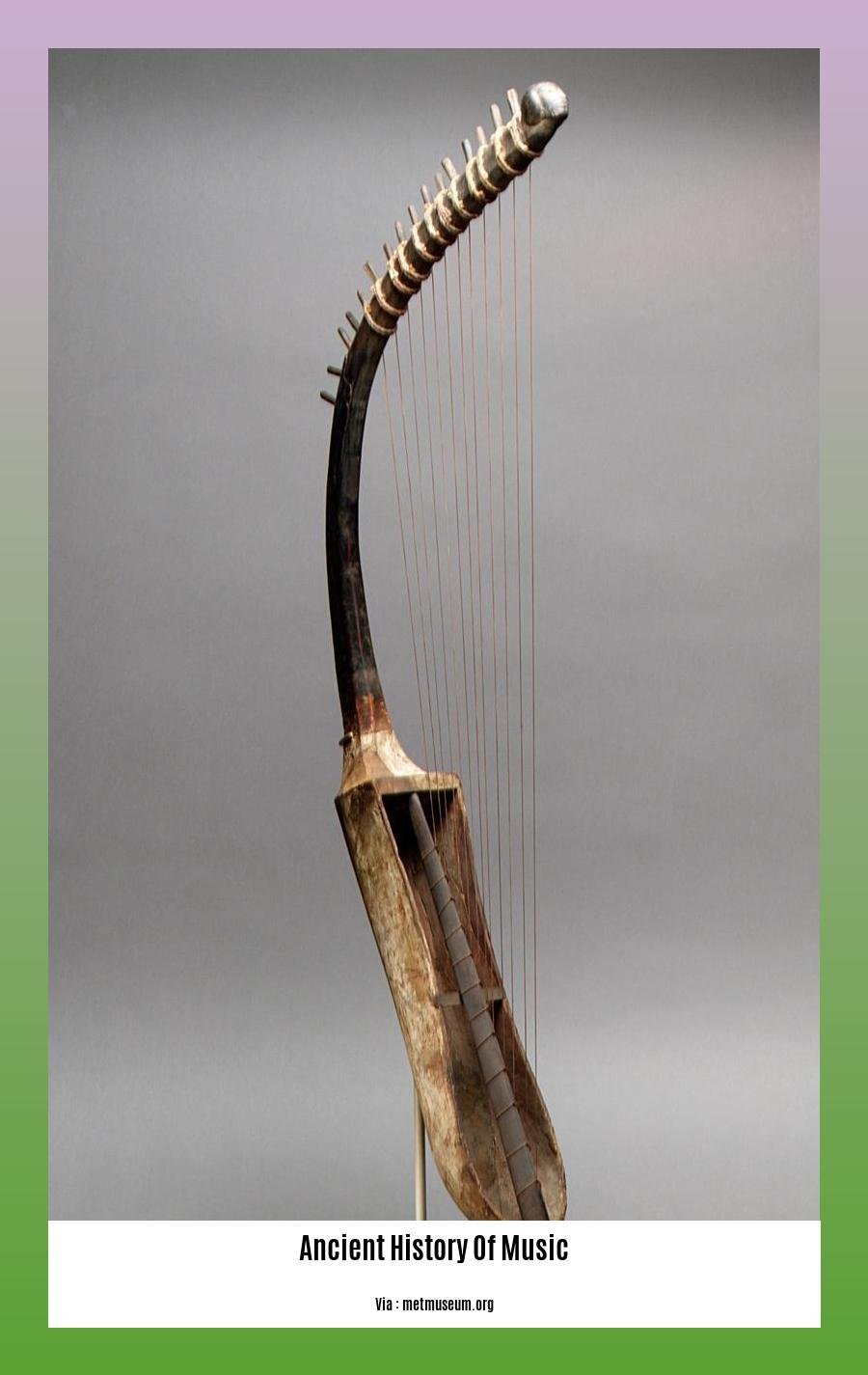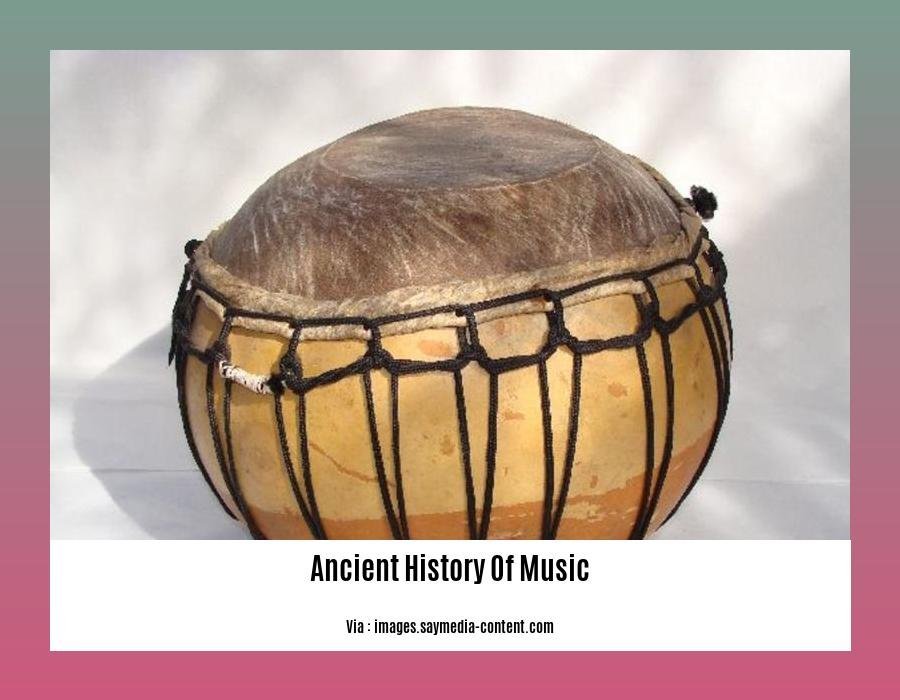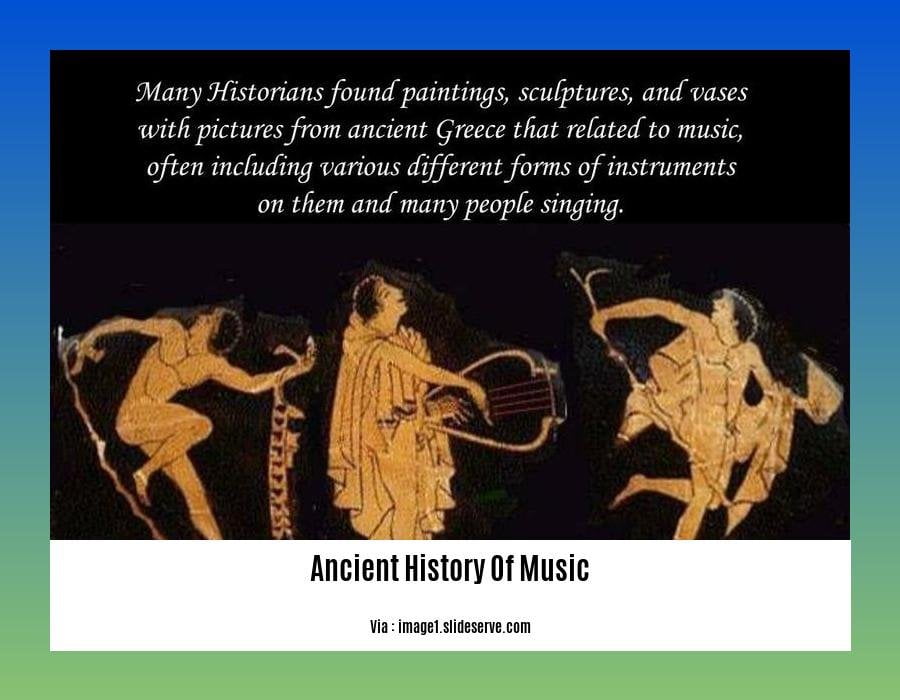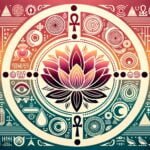Embark on an extraordinary journey through [Unveiling the Ancient History of Music: A Journey Through Time and Sound], where harmonious melodies and rhythmic beats echo from the depths of forgotten civilizations. We’ll unearth the secrets of ancient musical instruments, decipher cryptic musical notations, and reconstruct haunting soundscapes that once captivated our ancestors. Join us as we explore the profound role music played in shaping the cultural tapestry of the past.
Key Takeaways:
-
Ancient music evolved in literate civilizations of Mesopotamia, India, Persia, Egypt, China, Greece, and Rome, succeeding prehistoric music.
-
Significant events and dates in ancient music:
- 40,000 BCE: Bone flute
- 8000 BCE: Emergence of civilization
- 6000 BCE: Turkish wall paintings
- 3200 BCE: Invention of writing
- 1450-1250 BCE: Hurrian Songs
- 800 BCE: Rise of Greek city-states
- 500 BCE: Pythagoras
- 408 BCE: Stasimon Chorus from Euripides’ Orestes
Ancient History of Music

Embark on a captivating journey through the annals of sound as we unravel the ancient history of music. From the haunting melodies of prehistoric bone flutes to the sophisticated harmonies of ancient civilizations, music has played an integral role in shaping human history.
Tracing the Origins: The Birth of Civilization and Music
The ancient history of music is intertwined with the birth of civilization itself. As early as 8000 BCE, with the advent of settled communities, music emerged as a means of communication, storytelling, and spiritual expression.
The Power of Notation: Preserving Melodies Across Time
The development of writing systems marked a pivotal moment in the ancient history of music. Around 3200 BCE, the Sumerians of Mesopotamia invented cuneiform, the world’s earliest known writing system. This allowed for the notation of musical compositions, ensuring their preservation and transmission across generations.
Musical Crossroads: The Convergence of Cultures
As civilizations flourished and interacted, musical traditions merged and evolved. The ancient history of music witnessed the exchange of musical ideas between Mesopotamia, Egypt, Greece, India, and China. This cross-cultural pollination led to a rich tapestry of musical styles and instruments.
Musical Treasures: The Hurrian Songs and Greek Music Theory
Among the many musical gems unearthed from the annals of time, the Hurrian Songs stand out as some of the oldest surviving melodies. Composed between 1450 and 1250 BCE, these songs offer a glimpse into the musical world of ancient Mesopotamia.
In ancient Greece, music theory reached unprecedented heights. Philosophers such as Pythagoras and Aristoxenus developed sophisticated systems for understanding musical intervals and scales, laying the foundation for Western music theory.
Music and Rituals: Sound as a Sacred Offering
In ancient cultures, music held a profound spiritual significance. It was an integral part of religious ceremonies, rituals, and festivals. Music was believed to possess the power to appease the gods, heal the sick, and connect with the divine.
Musical Instruments: A Symphony of Innovation
The ancient history of music is replete with a diverse array of musical instruments, each reflecting the ingenuity and creativity of its creators. From the simple bone flutes of prehistoric times to the elaborate harps and lyres of ancient Egypt and Mesopotamia, musical instruments evolved to meet the needs of different cultures and musical styles.
Echoes of the Past: Music’s Enduring Legacy
The ancient history of music continues to resonate in the present day. Many contemporary musical traditions, instruments, and melodies can be traced back to their ancient roots. The enduring legacy of ancient music serves as a reminder of the timeless power of sound to transcend cultures, generations, and epochs.
-
Are you a history buff seeking to decipher the mysteries of Ancient Egypt? Embark on a journey to uncover the secrets of this civilization and the chronological divisions of its history in our comprehensive article: Ancient Egypt History Is Divided into 31.
-
Explore the depths of history and discover the untold stories of Jammu and Kashmir through our in-depth analysis of ancient history in the region. Immerse yourself in the chronicles of dynasties and empires, shedding light on the roots of this enigmatic land: Ancient History of Jammu and Kashmir.
-
Delve into the vast tapestry of ancient world history as we take you on a voyage through civilizations, events, and cultures that shaped our collective past. Discover forgotten empires, enigmatic artifacts, and the narratives that shaped the world as we know it: Ancient World History Topics.
Examination of cultural and religious contexts of ancient music, including its role in ceremonies, rituals, and storytelling
In ancient times, music held a special place, entwined with the very fabric of civilization. It was a potent force that transcended mere entertainment; it was a medium for cultural expression, a means of religious devotion, and a thread that ran through some of humanity’s most significant social rituals.
Music as Cultural Expression
Music has long been an integral part of cultural identity, reflecting the values, beliefs, and experiences of different societies. Take, for example, the ethnomusicologists who have dedicated their lives to studying the relationship between music and culture across diverse societies, shedding light on the ways in which music both shapes and is shaped by the communities it inhabits.
The Importance of Music
In ancient cultures, music played a prominent role in ceremonies, rituals, and celebrations, serving as a soundtrack to significant life events. Religious ceremonies, for instance, often incorporated music to honor deities, petition for divine favor, and create an atmosphere of transcendence. Music also enlivened social gatherings, whether it was a harvest festival or a royal banquet, enhancing the sense of community and collective joy.
Evidence for Music’s Existence
Archaeological excavations have uncovered tantalizing evidence suggesting that music has been a part of human existence since the Upper Palaeolithic era. Discoveries such as large handaxes reveal a sophisticated level of aesthetic sensitivity and abstraction, hinting at the possibility that our ancestors possessed a capacity for music making long before the advent of written records.
Key Takeaways:
-
Music in ancient cultures was deeply intertwined with cultural identity, expressing the values, beliefs, and experiences of different societies.
-
Music played a central role in religious ceremonies, rituals, and celebrations, honoring deities, enhancing transcendence, and creating a sense of community.
-
Archaeological evidence suggests that music has been a part of human existence since the Upper Palaeolithic era, with discoveries such as large handaxes indicating a capacity for music making long before written records.
Sources:
1. The Origins of Music: Evidence, Theory, and Prospects
2. Music | Art Form, Styles, Rhythm, & History
Discussion of the role of music in ancient civilizations, such as its use in entertainment, warfare, and communication

Music, a universal language that transcends time and cultures, played a vital role in ancient civilizations, deeply intertwined with their cultural fabric. From grand symphonies that echoed through royal courts to haunting melodies woven into religious ceremonies, music served as a powerful tool of expression, entertainment, and communication.
One of the most prominent roles of music in ancient civilizations was in the realm of entertainment. Music filled the air during feasts, celebrations, and social gatherings. Skilled musicians, often held in high esteem, performed on various instruments, delighting audiences with their melodies. In ancient Greece, for instance, music was an essential part of symposia, where guests enjoyed wine, conversation, and musical performances.
Music also played a crucial role in warfare, serving as a potent tool to boost morale, intimidate enemies, and coordinate troops. The rhythmic beat of drums reverberated through the battlefields, instilling courage and unity among soldiers. In ancient Rome, the military employed musicians to energize their legions as they marched into battle. These musicians performed martial music, using trumpets, horns, and drums to create a powerful soundscape that heightened the intensity of combat.
Beyond entertainment and warfare, music held a profound significance in religious rituals and ceremonies. It was believed to possess spiritual power, capable of appeasing deities, invoking divine presence, and facilitating communication with the spirit world. In ancient Egypt, music played a central role in temple rituals, with musicians accompanying religious ceremonies and processions. Similarly, in ancient India, music was an integral part of Vedic rituals, where it was used to chant sacred hymns and mantras.
Music also served as a medium for communication, conveying messages and stories across vast distances. In ancient Africa, the griots, or traditional storytellers, used music to preserve and transmit oral histories, recounting tales of heroism, love, and adventure. In the Americas, the Incas utilized a system of knotted strings called the quipu, which not only recorded numerical data but also conveyed musical information, allowing for the transmission of complex messages.
Key Takeaways:
- Music played a central role in ancient civilizations, serving various purposes such as entertainment, warfare, religious rituals, and communication.
- In ancient Greece, music was a vital part of symposia, where it provided entertainment and added to the convivial atmosphere.
- Ancient Rome employed musicians in the military to boost morale, intimidate enemies, and coordinate troops through martial music.
- Music held spiritual significance in many ancient cultures, accompanying religious ceremonies, rituals, and processions.
- Music served as a medium for communication, with griots in ancient Africa using it to transmit oral histories, and the Incas using quipus to convey both numerical and musical information.
Sources:
1. Music in Ancient Egypt
2. Music in the Ancient World
Exploration of the Influence of Ancient Music on Contemporary Music, Including the Use of Ancient Instruments and Melodies in Modern Compositions
Music, an integral part of our cultural fabric, transcends the boundaries of time, evolving through the ages while retaining its profound influence on contemporary music. Ancient music, with its rich tapestry of melodies and rhythms, continues to inspire and shape modern compositions, creating a harmonious bridge between the past and present.
Ancient Music: A Legacy of Sound
Ancient music encompasses the musical expressions of civilizations that predate the advent of written notation. These soundscapes were created using a diverse array of instruments, from simple percussion to intricate stringed and wind instruments.
Preservation and Evolution of Ancient Music
Despite the absence of written records, the legacy of ancient music has been preserved through oral traditions, archaeological discoveries, and iconographic representations. These sources provide glimpses into the melodies, rhythms, and instruments that formed the foundation of ancient musical practices. As civilizations evolved and interacted, musical traditions merged and transformed, giving rise to new sounds and styles.
The Enduring Influence
The influence of ancient music on contemporary music is multifaceted and profound. Modern composers and musicians continue to draw inspiration from the rich musical heritage of ancient civilizations.
-
Instruments: Ancient instruments, such as the lyre, flute, and drum, have been reinterpreted and adapted for use in modern compositions, lending a unique and authentic flavor to contemporary music.
-
Melodies: Many contemporary melodies bear striking similarities to ancient tunes. Composers may borrow directly from ancient sources or use them as a starting point for their own creations, creating a seamless blend of past and present sounds.
-
Rhythms: The rhythmic patterns of ancient music, often characterized by their complexity and intricacy, have also found their way into contemporary compositions, adding a sense of energy and vitality.
Case Study: “Ancient Echoes” by Contemporary Composer Anahita Abbasi
A prime example of the influence of ancient music on contemporary compositions is the work of Iranian-American composer Anahita Abbasi. Her composition, “Ancient Echoes,” features a unique blend of traditional Persian instruments, such as the santur and daf, with Western orchestral elements. Abbasi’s composition draws heavily on the rich musical heritage of ancient Persia, creating a mesmerizing soundscape that bridges the gap between past and present.
Global Impact: Ancient Music’s Reach
The influence of ancient music is not limited to the West. Many contemporary musicians from around the world are incorporating ancient elements into their work, creating a truly global musical landscape.
-
India: Indian classical music, with its roots in ancient Hindu traditions, continues to inspire contemporary Indian musicians, who blend traditional ragas and melodies with modern instrumentation and arrangements.
-
China: In China, ancient musical instruments, such as the guzheng and pipa, are experiencing a revival, with contemporary composers creating new compositions that showcase their unique sounds.
Key Takeaways
- Ancient music serves as a rich source of inspiration for contemporary composers and musicians.
- Ancient instruments, melodies, and rhythms are incorporated into modern compositions, creating a harmonious blend of past and present.
- Contemporary musicians from around the world are embracing ancient musical elements, fostering a global musical exchange.
Sources
- The Influence of Ancient Music on Contemporary Composition
- Ancient Music: Its Influence on Contemporary Composition
FAQ
Q1: What are the earliest known musical instruments?
A1: Among the earliest known musical instruments are bone flutes, dating back to 40,000 BCE, and cave paintings depicting musical instruments from 6000 BCE.
Q2: What role did music play in ancient cultures?
A2: Music played a significant role in ancient cultures, being used for religious ceremonies, social gatherings, cultural celebrations, and storytelling.
Q3: What are some notable ancient musical traditions?
A3: Notable ancient musical traditions include the Hurrian Songs from 1450-1250 BCE and the Greek city-states’ musical development beginning in 800 BCE.
Q4: How do we know about ancient music if written records are scarce?
A4: Archaeologists and researchers rely on archaeological evidence, such as musical instruments, cave paintings, and written texts, to understand and reconstruct ancient music.
Q5: What are some of the challenges in studying ancient music?
A5: Studying ancient music presents challenges due to the scarcity of written musical notation, the fragmentary nature of archaeological evidence, and the need for specialized knowledge to interpret and reconstruct ancient musical practices.
- Unveiling the Enigma: Mansoureh Khojasteh Bagherzadeh’s Public Appearances & Private Life in Iran - July 18, 2025
- Unveiling the Mystery: Mansoureh Khojasteh Bagherzadeh’s Husband: A Rare Glimpse into a Private Life - July 18, 2025
- Unveiling Masoud Khamenei’s Mother: Power, Influence, and Iran’s Future - July 18, 2025
















